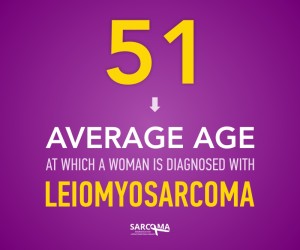Diagnosis
Diagnosis of Leiomyosarcoma
 Whether you discovered that you have Leiomyosarcoma, or LMS, during a regular physical exam or because you were experiencing the most common symptoms, the next step is to diagnosis the seriousness of your particular case.
Whether you discovered that you have Leiomyosarcoma, or LMS, during a regular physical exam or because you were experiencing the most common symptoms, the next step is to diagnosis the seriousness of your particular case.
Before we start to look at a diagnosis of LMS, let’s consider the amazing range of ways this disease manifests and how it can be so different in one person to the next.
LMS Varies
The condition, as you may now know, is one in which malignant tumors (cancerous tumors) form in the soft tissue of the body. The soft tissue it appears in is known as involuntary muscle. This is not the muscle you would use if you were tightening up your abdomen during exercise or using to form your lips into a whistle. Instead, these are the muscles that you are entirely unaware of – the muscles that cause your intestines to contract and digest food, the muscles that raise goose bumps on your skin, and so on.
The muscles are also those inside your blood vessels, and this means that LMS usually travels through the bloodstream (instead of the lymphatic system) and can appear in almost any part of the body.
Additionally, the severity of it, and the extent to which it has metastasized (spread) will also vary widely from person to person. Regardless of the site of your LMS, you will have developed at least one tumor, and this is how your medical team is going to begin to make your complete diagnosis.
A Variety of Tests
And just as LMS appears in so many places and in a wide variety of ways, it has to be tested using an array of diagnostics as well. After all, it may be uterine LMS and require an entirely different method of diagnosis than LMS that appears on the arm or leg. Typically, the following equipment is put to use in diagnosing the condition:
- Ultrasound scan
- CT scan
- MRI
- Hysteroscopy
- Biopsy
Generally, the biopsy is done only if it is suspected that you do have LMS. Taking a small sample of the tissue of the tumor or the area affected is the only conclusive way of verifying that you do have the condition and then “grading” and “staging” it.
Grading and Staging LMS
A biopsy provides a physician with the cells needed to first detect if cancer is present or not. After that, they can then use the sample to understand just what sort of cancer is present. After that, they will grade the cells. What this means is that scientists can usually gauge how quickly cancer is working and will indicate that it is low grade if it is not showing much activity or high grade if it seems particularly abnormal or likely to advance quickly.
At the same time that any biopsy is being graded, it is going to be staged, as well. According to the experts, the, “Stage of a cancer is a term used to describe its size and whether it has spread beyond its original site. Knowing the particular type and the stage of the cancer helps the doctors decide on the most appropriate treatment.” (Macmillan.org, 2015)
Though staging is not usually done on gynecological LMS, it is used for all of the other forms. The stages range from 1A (being the lowest level and lowest grade) to Recurrence, which indicates a return of soft tissue sarcoma after it has already been treated.
Leiomyosarcoma Diagnosis Scale:
1A – Low grade, superficial, small, but without any sign of spread
1B – Low grade, large, but deeper within the body, although also without sign of spread
2A – Low grade, large, deep in the body, no sign of spread
2B – High grade, small, superficial or deep, no sign of spread
2C – High grade, large, superficial, but no sign of spread
3 – High grade, large, deep in the body, no sign of spread
4 – This tumor is the type to have spread (metastasized) and is considered a secondary sarcoma.
Recurrence – As indicated this is one that has returned or has appeared as a metastasized tumor elsewhere in the body
Once a diagnosis is done, your medical team can then begin to help you plan for treatment.
Source
Macmillan.org. Leiomyosarcoma. 2015. http://www.macmillan.org.uk/Cancerinformation/Cancertypes/Softtissuesarcomas/Typesofsofttissuesarcomas/Leiomyosarcoma.aspx#DynamicJumpMenuManager_6_Anchor_3
